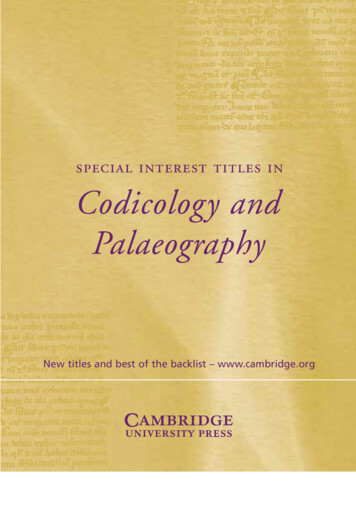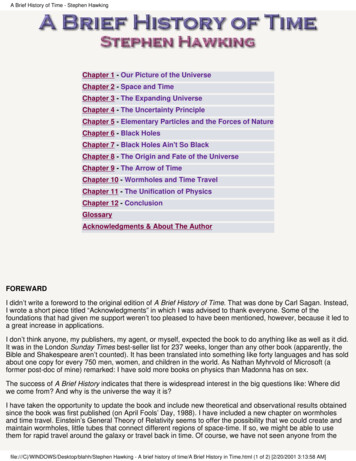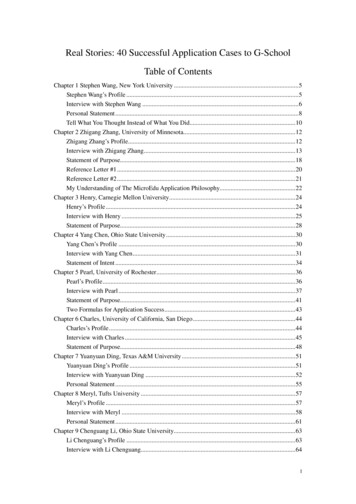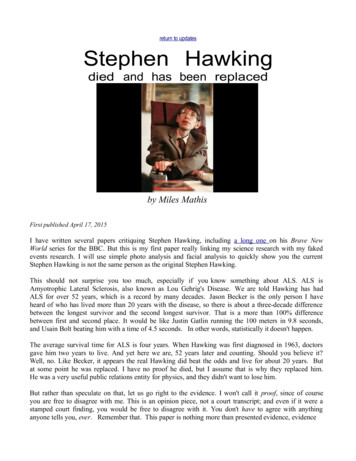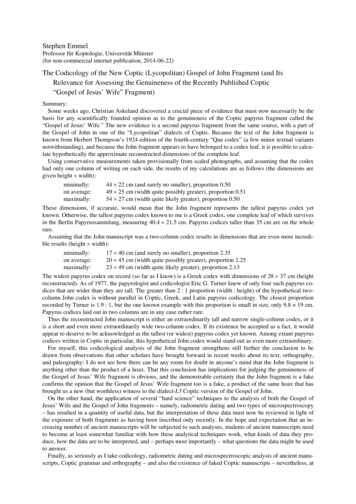
Transcription
Stephen EmmelProfessor für Koptologie, Universität Münster(for non-commercial internet publication, 2014-06-22)The Codicology of the New Coptic (Lycopolitan) Gospel of John Fragment (and ItsRelevance for Assessing the Genuineness of the Recently Published Coptic“Gospel of Jesus’ Wife” Fragment)Summary:Some weeks ago, Christian Askeland discovered a crucial piece of evidence that must now necessarily be thebasis for any scientifically founded opinion as to the genuineness of the Coptic papyrus fragment called the“Gospel of Jesus’ Wife.” The new evidence is a second papyrus fragment from the same source, with a part ofthe Gospel of John in one of the “Lycopolitan” dialects of Coptic. Because the text of the John fragment isknown from Herbert Thompson’s 1924 edition of the fourth-century “Qau codex” (a few minor textual variantsnotwithstanding), and because the John fragment appears to have belonged to a codex leaf, it is possible to calculate hypothetically the approximate reconstructed dimensions of the complete leaf.Using conservative measurements taken provisionally from scaled photographs, and assuming that the codexhad only one column of writing on each side, the results of my calculations are as follows (the dimensions aregiven height width):minimally:44 22 cm (and surely no smaller), proportion 0.50on average:49 25 cm (width quite possibly greater), proportion 0.51maximally:54 27 cm (width quite likely greater), proportion 0.50These dimensions, if accurate, would mean that the John fragment represents the tallest papyrus codex yetknown. Otherwise, the tallest papyrus codex known to me is a Greek codex, one complete leaf of which survivesin the Berlin Papyrussammlung, measuring 40.4 21.5 cm. Papyrus codices taller than 35 cm are on the wholerare.Assuming that the John manuscript was a two-column codex results in dimensions that are even more incredible results (height width):minimally:17 40 cm (and surely no smaller), proportion 2.35on average:20 45 cm (width quite possibly greater), proportion 2.25maximally:23 49 cm (width quite likely greater), proportion 2.13The widest papyrus codex on record (so far as I know) is a Greek codex with dimensions of 28 37 cm (heightreconstructed). As of 1977, the papyrologist and codicologist Eric G. Turner knew of only four such papyrus codices that are wider than they are tall. The greater than 2 : 1 proportion (width : height) of the hypothetical twocolumn John codex is without parallel in Coptic, Greek, and Latin papyrus codicology. The closest proportionrecorded by Turner is 1.9 : 1, but the one known example with this proportion is small in size, only 9.8 19 cm.Papyrus codices laid out in two columns are in any case rather rare.Thus the reconstructed John manuscript is either an extraordinarily tall and narrow single-column codex, or itis a short and even more extraordinarily wide two-column codex. If its existence be accepted as a fact, it wouldappear to deserve to be acknowledged as the tallest (or widest) papyrus codex yet known. Among extant papyruscodices written in Coptic in particular, this hypothetical John codex would stand out as even more extraordinary.For myself, this codicological analysis of the John fragment strengthens still further the conclusion to bedrawn from observations that other scholars have brought forward in recent weeks about its text, orthography,and paleography: I do not see how there can be any room for doubt in anyone’s mind that the John fragment isanything other than the product of a hoax. That this conclusion has implications for judging the genuineness ofthe Gospel of Jesus’ Wife fragment is obvious, and the demonstrable certainty that the John fragment is a fakeconfirms the opinion that the Gospel of Jesus’ Wife fragment too is a fake, a product of the same hoax that hasbrought us a new (but worthless) witness to the dialect-L5 Coptic version of the Gospel of John.On the other hand, the application of several “hard science” techniques to the analysis of both the Gospel ofJesus’ Wife and the Gospel of John fragments – namely, radiometric dating and two types of microspectroscopy– has resulted in a quantity of useful data, but the interpretation of these data must now be reviewed in light ofthe exposure of both fragments as having been inscribed only recently. In the hope and expectation that an increasing number of ancient manuscripts will be subjected to such analyses, students of ancient manuscripts needto become at least somewhat familiar with how these analytical techniques work, what kinds of data they produce, how the data are to be interpreted, and – perhaps most importantly – what questions the data might be usedto answer.Finally, as seriously as I take codicology, radiometric dating and microspectroscopic analysis of ancient manuscripts, Coptic grammar and orthography – and also the existence of faked Coptic manuscripts – nevertheless, at
the end of my paper I offer a somewhat light-hearted bit of food for thought in connection with the question ofwhat might have motivated the person who faked these Coptic papyri.Contents:Introduction . . . . . . . . . . . . . . . .How Much Text Is Missing from the “Harvard John Fragment”? . .What Are the Dimensions of the Harvard John Fragment? . . . .Reconstructing a Complete Codex Leaf from the Harvard John FragmentComparison of Reconstructed “Codex H” with Extant Papyrus CodicesAn Alternative Reconstruction: A Two-Column Codex H? . . . .No Codicological Reconstruction of H Is Entirely Credible . . . .Conclusions from the Codicological Analysis . . . . . . .The Spectroscopic Studies: A Critique from a Layman . . . . .P.S. Yet More Nails for the Coffin? . . . . . . . . . .P.P.S. Was the New Gospel of John Fragment Meant to Be a Joke?.11236101213142224
THE CODICOLOGY OF THE NEW COPTIC (LYCOPOLITAN)GOSPEL OF JOHN FRAGMENT( AND I TS R ELEVANCE FOR A SSESSING THE G ENUINENESS OF THE R ECENTLYP UBLISHED C OPTIC “G OSPEL OF J ESUS ’ W IFE ” F RAGMENT )Stephen EmmelProfessor für Koptologie, Universität Münster(for non-commercial internet publication, 2014-06-22)Introduction1. Some weeks ago, Christian Askeland discovered a crucial piece of evidence that mustnow necessarily be the basis for any scientifically founded opinion as to the genuineness ofthe Coptic papyrus fragment called the “Gospel of Jesus’ Wife” (GJW), recently published byKaren King.1 The crucial new evidence is a second papyrus fragment from the same source,with a part of the Gospel of John (5:26–6:14) in one of the “Lycopolitan” dialects of Coptic,namely dialect L5. The John fragment is mentioned briefly in King’s publication (p. 154n. 107), as she had mentioned it also in a draft of her article posted on line in September 2012,but photographs of the fragment, and thus also the first detailed information about it, becameavailable only in April 2014, in two technical reports posted on line at the same time as theappearance of the printed publication of GJW.2 As Askeland discovered, the text of the Johnfragment is effectively identical to the text of the main witness to the L5-version of John,namely the fourth-century papyrus “Qau codex” (discovered in an archeological excavation inUpper Egypt in 1923), and in particular to Herbert Thompson’s careful edition of it, which required critical restoration of a number of lacunas throughout the damaged manuscript, hereafter abbreviated T.3 Joost Hagen has provided a useful transcription of the text of the “Harvard John fragment,” as it may be called temporarily, hereafter abbreviated H, prepared on thebasis of the photographs available on the internet, with restorations of the lacunas basedon T.4 On the basis of a collation of the text of H against that of T, Askeland had alreadyconcluded that H is a modern forgery. Here I offer the results of a codicological analysis of H,which provide additional evidence that it is a fake.How Much Text Is Missing from the “Harvard John Fragment”?2. Because the text of H is known from T (a few minor textual variants notwithstanding),one can calculate with near certainty how much text is missing not only from the broken lineson H’s recto and verso, but also between the last line of the recto and the first line of theverso. These calculations are easy, both because the left margin survives on H’s recto and the1Karen L. King, “‘Jesus Said to Them, “My Wife . . .”’: A New Coptic Papyrus Fragment,” Harvard Theological Review 107 (2014) 131–159. See also: Christian Askeland, “Jesus Had a Sister-in-Law” (2014-04-24) at http://evangelicaltextualcriticism.blogspot.de. I am grateful to Dr. Askeland for the many ideas and pieces of information and advice that he has shared with me over the course of the past several weeks.2James T. Yardley and Alexis Hagadorn, “Report: Ink Study of Two Ancient Fragments through MicroRaman Spectroscopy” (2013-05-13) at ardleyharvardfragmentreportrev07.pdf, pp. 6–7 figs. 4.1 and 4.2; Joseph M. Azzarelli et al., “Study of Two Papyrus Fragments withFourier Transform Infrared Microspectroscopy” (2013-12-27) at wagergjwtirffinalreport.pdf, pp. 11–12 figs. 7 and 8.3Herbert Thompson, The Gospel of St. John According to the Earliest Coptic Manuscript (London 1924),pp. 7–9 for the passage relevant to the new fragment of John.4Joost L. Hagen “Possible Further Proof of Forgery: A Reading of the Text of the Lycopolitan Fragment ofthe Gospel of John” etc. (2014-04-30) at -on-the-forged-gospel-of-john-fragment.pdf, pp. [2]–[3].Stephen Emmel, The Codicology of the New Coptic John Fragment (2014-06-22), p. 1
right margin on its verso, and because every surviving line of the fragment, both recto andverso, begins and/or ends exactly where lines in T begin or end, according to the pattern thatone line of H equals exactly two lines of T, except for H verso line 8, which corresponds toonly one line of T, namely Coptic p. 25 line 1 (i.e., T 25:1, Thompson, p. 9).53. It is a reasonable assumption that if additional fragments of H were to come to light,they would conform to this same pattern of correspondence with T. On the assumption thatthe last line of H recto (Hr) corresponds exactly to T 21:23–24, and the first line of H verso(Hv) to T 24:20–21, the text of John 5:31–6:11 that is missing between the last surviving lineof Hr and the first surviving line of Hv occupies 102 lines of T (21:25–36 22:1–36 23:1–35 24:1–19), which in H’s layout would be 53 lines, the “proportional extension of text”6between H and T being 15/29 0.52, calculating only on the basis of those lines of H forwhich we can be certain about the line breaks at both beginning and end, which is 8 lines onthe recto (out of 9), 7 on the verso (out of 8). However, because the last line on the verso isclearly aberrant (as mentioned in § 2 above), it is better to omit this line too from the calculation. Doing so results in a proportional extension of text of 14/28 0.50 exactly, so that wemay assume that 102 0.50 51 lines of text are missing between recto and verso of H.What Are the Dimensions of the Harvard John Fragment?4. Before proceeding, it is necessary to establish the physical dimensions of H, whichhave not yet been clearly and explicitly reported. So far as I know, the best indication of thesize of H is a photograph included in one of the technical reports, where H and GJW areshown lying near enough to one another on atable that one can estimate their relative sizes(see fig. 1). Although the image is small andincludes no scale, one can see that H is abouttwice as tall as GJW and also somewhatwider. (From the greatly magnified imagesof GJW that have been in wide circulationon the internet, one can easily get the opposite impression, even that GJW is significantly larger than H.) GJW has been reported to be ca. 4 ca. 8 cm (height width;see King, p. 133). From these dimensionsand a close look at the image reproducedhere in fig. 1, one can estimate H to be about Fig. 1: David Ratzan examines the Harvard John fragment(Hv), which lies to the left of GJW and is plainly larger than8 10 cm. This estimation is nearly the GJW (image from Yardley & Hagadorn, p. 4 fig. 3.3).same as the dimensions reported in one ofthe documents that accompany GJW and H, as reported by Prof. King: a papyrus in the samecollection “having nine lines of writing, measuring approximately 110 by 80 mm, and containing text from the Gospel of John”7 is presumably the John fragment that I am here callingH. For the more precise measurements that are needed for a codicological analysis of the Johnfragment, it would seem that we have recourse to two of the four published photographs of H5There are several possible explanations for this aberration in H, but it is in any case of no great consequencefor the codicological analysis presented here.6See Stephen Emmel, “On Using ‘Proportional Extension of Text’ as a Criterion for Placing Fragments in aDismembered Codex,” in: Christianity in Egypt: Literary Production and Intellectual Trends. Studies in Honorof Tito Orlandi, edited by Paola Buzi and Alberto Camplani (Studia Ephemeridis Augustinianum 125; Rome2011), pp. 257–278 (referred to by King, p. 133 n. 5).7King, p. 154 n. 107, photocopy of TLS, P. Munro to H. U. Laukamp, 1982-07-15, translated by King fromGerman (cf. p. 153: “photocopies of correspondence in German”).Stephen Emmel, The Codicology of the New Coptic John Fragment (2014-06-22), p. 2
referred to at the beginning of this paper (n. 2 above). In all four photographs, a yellow gridhas been superimposed onto the images of H, and in two of them, Azzarelli et al. figs. 7 and 8( recto and verso), one square of the superimposed grid is labelled as being 0.50 0.50 cm(see fig. 2, upper left), which is the same scalethat is given to the grid that is superimposedonto the photographs of GJW in the same report(figs. 5–6). But if one measures the photographsof H according to this scale, the dimensions areat most 3.8 5.2 cm (height width), which is alittle less than half the size given by Munro inhis letter to Laukamp. These dimensions makeH about as tall as GJW and about two thirds aswide, which is not the case, as is clear fromfig. 1. Therefore, the scale printed with Azzarelli et al.’s fig. 7 (our fig. 2) must be too large.5. In the absence of any precisely recordedmeasurements of H, it seems to me to be a rea- Fig. 2: The John fragment, recto, shown with a grid susonable working hypothesis that the scale used perimposed onto it, and a scale (upper left) added to theby Azzarelli et al. is correct for GJW (i.e., one grid (image from Azzarelli et al., p. 11 fig. 7). But thescale can be shown to be too large for this photograph.square of the grid is 0.5 0.5 cm, according towhich the dimensions of GJW are 4.1 8.4 cm, in close accord with the measurements reported by King), but too large for the Harvard John fragment. If one assumes that the scale forH is exactly twice as large as it should be for the images onto which the grid and the scalewere superimposed, then the dimensions for H come out to be (according to my measurements) 7.6 10.3 cm, which is roughly in line both with the reported dimensions of 8 11 cm(height width) and with my estimation based on fig. 1. Others might get slightly differentresults depending on their technique for correcting the scale and for taking measurements,with variation of a few millimeters being likely (according to my experience of such things).Reconstructing a Complete Codex Leaf from the Harvard John Fragment6. It appears that H belongs to a codex leaf: the margins and text lines on recto and versoare approximately in alignment with one another, and the height and spacing of the lines oftext on both pages are more or less uniform, all within the limits of the variation that one mayexpect to find in an ancient papyrus codex. In order to reconstruct what would have been theoriginal dimensions of the codex leaf to which the surviving fragment appears to have belonged, one can make codicological calculations based on what survives.87. In order to calculate the width of the hypothetical original column, I have measuredthe extension of each string of surviving letters in each line, always including the interliteralspace after each letter (i.e., to the right of it) and avoiding including in my measurements anyvery damaged or indistinct letters. For the recto, my measurements range between 0.40 and0.51 cm for 1 letter 1 interliteral space, for the verso between 0.49 and 0.60 cm, and the8I will give only some of the details of my measurements and calculations. Others who might try to measurethe same phenomena may get slightly different measurements. Judging from my experience in codicology, Iwould expect to get slightly different measurements myself if I were to take them all a second time. There is nota single, precise, and correct measurement when it comes to the kinds of phenomena that we are dealing withhere, because in most respects manuscript books are not absolutely precisely uniform and consistent. But I alsoknow from experience that the inevitable minute “imprecisions” in measurements of a manuscript’s codicological features are not significant for the end results of the kinds of calculations offered here. (I put “imprecisions”into quotation marks because it is not necessarily the measurements as such that are imprecise, but rather thephenomena being measured fluctuate in degree and are thus, in a sense, themselves “imprecise” by their verynature.)Stephen Emmel, The Codicology of the New Coptic John Fragment (2014-06-22), p. 3
average from all my measurements on both sides together is 0.51 cm. On the recto, the widthof the surviving written area is at least (i.e., minimally) 7.2 cm. Using 21.5 for the averagenumber of letters per line that are missing to the right of the surviving recto,9 I get a columnwidth of minimally 21.5 0.40 8.6 7.2 15.8 cm, maximally 21.5 0.60 12.9 7.2 20.1 cm or more,10 with an average of at least 21.5 0.51 11.0 7.2 18.2 cm. Thesurviving left and right margins are minimally 3.0 cm, maximally 3.4 cm, so that I calculate atotal page width (column of text two margins) of minimally 15.8 6.0 21.8 cm, maximally 20.1 6.8 26.9 cm or more, on average at least 18.2 6.4 24.6 cm (see table 1).8. For calculating the original height of the codex leaf of which H appears to be a fragment, we need to know how many lines were on a page, and how tall one line is. We do notknow whether H preserves the first line of each page, or the last line, or comes from somewhere in the middle of our hypothetical leaf. But this is no hindrance to the calculation. Let usassume that H comes from the very top of the column.11 In this case, the number of lines onthe recto must have been the number of surviving lines on the recto plus the number of linesthat we calculated as missing before the first surviving line of the verso, that is: 9 51 60lines. But now let us assume that H comes from the very bottom of the column. In that case,the number of lines on the verso must have been the number of lines that we calculated asmissing before the first surviving line of the verso plus the number of surviving lines on theverso, that is: 51 8 59 lines. Any other assumed position of the fragment on the leaf willbring one or the other of these two results, because the position of H on the recto page necessarily determines its position on the verso, and the number of lines missing between recto andverso is fixed at 51. Only because of a difference in interlinear spacing between recto and verso do we have here a minimal and a maximal possibility, namely 59 lines and 60 lines perpage.9. On the recto, the height of 8 lines plus the interlinear spaces (that is, measured fromthe top of line 1 to the top of line 9) is 5.5 cm. Similarly on the verso, the height of 7 lines isTABLE 1C ALCULATION OF THE O RIGINAL P AGE W IDTH OF THE H ARVARD J OHN F RAGMENT(Assuming a One-Column Layout)STEPS IN THE CALCULATIONMINIMALAVERAGEMAXIMAL(a)1 letter 1 interliteral space0.40 cm0.51 cm0.60 cm(b) letters missing per line(c) width of lacuna8.6 cm(d) surviving width of column7.2 cm(e) width of column(f) width of surviving margins 2(g) width of page21.511.0 cm12.9 cm15.8 cm18.2 cm20.1 cm6.0 cm6.4 cm6.8 cm21.8 cm24.6 cm26.9 cm9I may note here that Hagen included in the margins of his transcription (see n. 4 above) useful data for suchcalculations.10“Or more” because the figures that I am using are more likely to be too small than too large.11This hypothesis has been sketched graphically by Gregg W. Schwendner, “Crude Analysis of the N[umber]of Lines Separating Cod[ex] Recto and Cod[ex] Verso of the Simulated GJohn” (n.d.) at https://www.academia.edu/6893103/crude analysis of the no. of lines separating cod. recto and cod. verso of the simulated gjhn.Stephen Emmel, The Codicology of the New Coptic John Fragment (2014-06-22), p. 4
5.5 cm. As one can see in the photographs, the lines on the verso are somewhat more widelyspaced than the lines on the recto are, and also the letters on the verso appear to be slightlytaller than the letters on the recto (and on the verso they are also more widely spaced). On therecto, 1 line 1 interlinear space is (on average) 5.5/8 0.6875 cm, on the verso 5.5/7 0.7857 cm, and on average for both sides together 11/15 0.7333 cm.12 Now we can combinethese results with the number of lines per page and obtain, for the original height of the column of writing, minimally 0.6875 59 40.6 cm, maximally 0.7857 60 47.1 cm, onaverage 0.7333 59.5 43.6 cm. Because these calculations have the result of adding in onesuperfluous interlinear space at the bottom of the column, let us reduce each result by 0.4 cm,which is a generous approximation of the height of one interlinear space: thus minimally 40.2cm, on average 43.2 cm, maximally 46.7 cm. We must also add top and bottom margins, forwhich 2 2 4 cm is a conservative estimate, given that the surviving inner margin is about 3cm wide; for an approximate “average” let us use 6 cm, and for a maximum (but still ratheron the conservative side) let us use 7.5 cm.13 Thus I calculate a total page height (column oftext top margin bottom margin) of minimally 40.2 4.0 44.2 cm, on average at least43.2 6.0 49.2 cm, and maximally 46.7 7.5 54.2 cm or more (see table 2).10. The final results for the dimensions of a leaf of our hypothetical one-column earlymedieval Coptic papyrus codex H would be as follows (height width, with the figuresrounded for simplicity’s sake, because we are dealing here in any case with approximations):minimally44 22 cm (and surely no smaller14)on average49 25 cm (width possibly greater)maximally54 27 cm (width likely greater)TABLE 2C ALCULATION OF THE O RIGINAL P AGE H EIGHT OF THE H ARVARD J OHN F RAGMENT(Assuming a One-Column Layout)STEPS IN THE CALCULATION(a)1 line 1 interlinear space(b) total lines on page(c) height of columnMINIMALAVERAGE0.6875 cm0.7333 cm5959.56040.6 cm43.6 cm47.1 cm(d) – 1 interlinear space(e) adjusted height of column(f) height of top bottom margins(g) height of pageMAXIMAL0.7857 cm0.4 cm40.2 cm43.2 cm46.7 cm4.0 cm6.0 cm7.5 cm44.2 cm49.2 cm54.2 cm12Schwendner, “Analysis” (n. 11 above), gives the figure for the “leading” (1 line 1 interlinear space) of theJohn fragment as only 0.60 cm, without reporting how he obtained this figure. As a result, his calculation of theheight of the column of text (36 cm) is smaller than my minimal calculation (ca. 40.2 cm).13The papyrologist E. G. Turner (see n. 15 below) observed that “a rule of thumb would allow the lower margin to be bigger in proportion of 3 : 2 than the upper margin” (Turner, p. 25). I was reminded of this sentence inTurner’s book recently while reading Brent Nongbri, “Losing a Curious Christian Scroll but Gaining a CuriousChristian Codex: An Oxyrhynchus Papyrus of Exodus and Revelation,” Novum Testamentum 55 (2013) 77–88(p. 80 at n. 10), which is an informative and useful exercise in codicological reconstruction.14“And surely no smaller” because I have used very conservative minimal values at every step, both when calculating the height and when calculating the width.Stephen Emmel, The Codicology of the New Coptic John Fragment (2014-06-22), p. 5
Comparison of Reconstructed “Codex H” with Extant Papyrus Codices11. Anyone who is familiar with the codicology of papyrus codices will know immediately that even the minimal height of 44 cm is surprisingly tall, while a height of 54 cm would beastonishing. According to data collected byE. G. Turner as of the mid-1970s, from something more than seven hundred papyrus codicesor fragments of papyrus codices (48 of thembeing Coptic),15 the tallest known Coptic papyrus codex is his no. C22, which is H. Thompson’s “Books of the Old Testament” codex,“the largest dimensions of complete pages” being 36.5 26.5 cm (with 33–38 lines per pageand an average written area of 28 21 cm),16so about the same width as our hypothetical codex H, but noticeably shorter.12. Codex H could be taller than the tallestGreek or Latin papyrus codex known to Turner, which is P.Berl. inv. 11739 (assigned tothe sixth or seventh century). From this codexthere survives one well preserved leaf (plus afew fragments of at least one further leaf), suchthat the original dimensions of the codex canbe directly measured as 40.4 21.5 cm (seefig. 3).17 Unless a taller papyrus codex has beendiscovered in the meantime, our hypotheticalL5 John codex is at the very least about 4 cmtaller than this tallest of all known papyrus codices and more likely 10 cm taller, or more.The papyrus leaf in Berlin is written in onecolumn ca. 27 13 cm, with 38 lines per page(not counting a three-line title on the recto that Fig. 3: P.Berl. inv. 11739Ar (40.4 21.5 cm, the tallestis written in the top margin, not within the col- known papyrus codex leaf, Turner’s no. 84; for theumn of text, as is clear from a comparison with source of the image, see n. 17); the heading stands inthe top margin and is not a part of the column of textthe verso); the inner margin is the same width (cf. verso); yellow marks an area approximately equivas the surviving inner margin of H, ca. 3 cm, alent to H in its proportions relative to the column.but the three other margins are each ca. 6 cmwide. If we use the margins of the Berlin leaf in our calculations of the size of H, which is notunreasonable given H’s large size, we get dimensions between 52 25 cm and 59 29 cm, a15Eric G. Turner, The Typology of the Early Codex ([Philadelphia] 1977); cf. n. 38 below.Herbert Thompson, The Coptic (Sahidic) Version of Certain Books of the Old Testament from a Papyrus inthe British Museum (London 1908), p. vi; see the frontispiece for a photograph (British Library Or. 5984[41]v;reproduced by Frank Feder, “The Coptic Versions of the Book of Jesus Sirach,” in: Studies in the Book of BenSira, edited by Géza G. Xeravits and József Zsengellér [Journal for the Study of Judaism Supplement 127; Leiden and Boston 2008], 11–20, p. 19).17This codex is Turner’s no. 84 (see pp. 14 and 105) LDAB 1074 P.Berl. inv. 11739 (A the completeleaf, B the fragments). For the dimensions, see Alfred Körte, “Literarische Texte mit Ausschluss der Christlichen,” Archiv für Papyrusforschung 11 (1935) 220–283, pp. 275–276 no. 825. For scaled color photographs,see: http://smb.museum/berlpap/index.php/03284 (accessed 2014-05-17). The text that begins on the recto is aNeoplatonic commentary on a work of Galen, by an otherwise unknown author named Archimedes or Archonides (it is not a work by Galen himself, as labelled by Turner, following the way this work was listed by Roger A.Pack, The Greek and Latin Literary Texts from Greco-Roman Egypt [2d ed.; Ann Arbor 1965], 44 no. 456).16Stephen Emmel, The Codicology of the New Coptic John Fragment (2014-06-22), p. 6
truly gigantic papyrus codex (see fig. 4). Among Turner’s papyrus codices, there are threethat have been reconstructed as having been as tall as 40 cm or more, as follows.18No. 236 P.Berl. inv. 10567 BKT 5.1 no. 10 LDAB 3077, Greek, Nonnos, Dionysiaka; two fragmentary bifolia (ff. 2 3 the center of a quire) and one fragmentary leaf (assigned date: sixth century19); calculated by its editors to have been ca. 40 28 cm.20 Thebifolium ff. 1 4 appears to survive to its full width, with wide outer margins, so that thecodex was probably never any wider than its present extant width of 28 cm. Because thetext is known and poetic, and parts of top margins survive (bottom margins are all wanting), calculating the numbers of missing lines, and thus the height of the column, is reasonably secure: for f. 1r the result is ca. 32.5 cm, with 48 lines (other pages have only 37–45 lines, not counting f. 1v, on which a title occurs in the middle of the column). On f. 4,the top margin survives up to ca. 3 cm (f. 1 is less well preserved, and I have no data forff. 2 and 3). It seems that the editors allowed ca. 7.5 cm for top and bottom marginsFig. 4: The relative sizes of P.Berl. inv. 11739A (40.4 21.5 cm) and T (25 12.5 cm) as compared to reconstructed codex H (assuming a one-column layout), the latter calculated both minimally (44 22 cm) and maximally (54 27 cm), and also extra-maximally (max , 59 29 cm)by adopting the widths of the Berlin codex’s margins (if the proportion of the Berlin codex’smargins to its written area were to be used instead of their absolute dimensions, then H max would be even larger).18By “reconstructed,” I mean that the dimensions of the original codices must be calculated on the basis ofsurviving fragments, just as we have reconstructed the dimension
Jun 22, 2014 · confirms the opinion that the Gospel of Jesus’ Wife fragment too is a fake, a product of the same hoax that has brought us a new (but worthless) witness to the dialect-L5 Coptic version of the Gospel of John. On the other hand, the application of several “hard science” techniques to the
